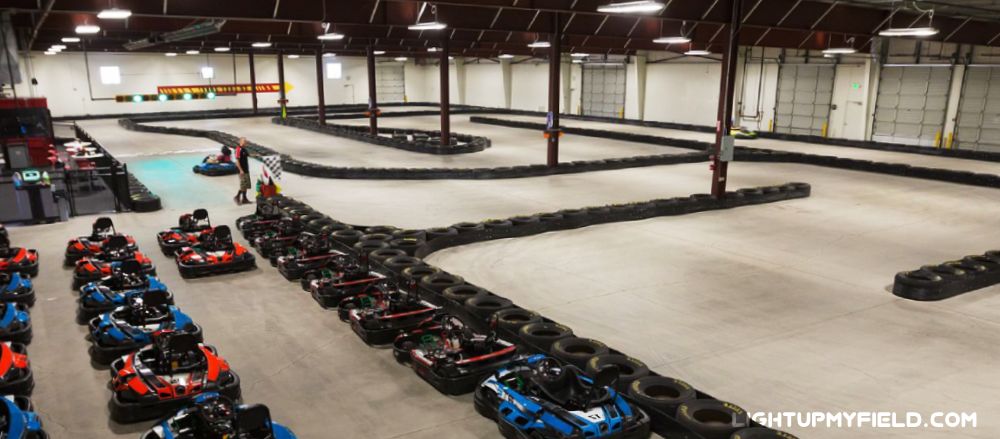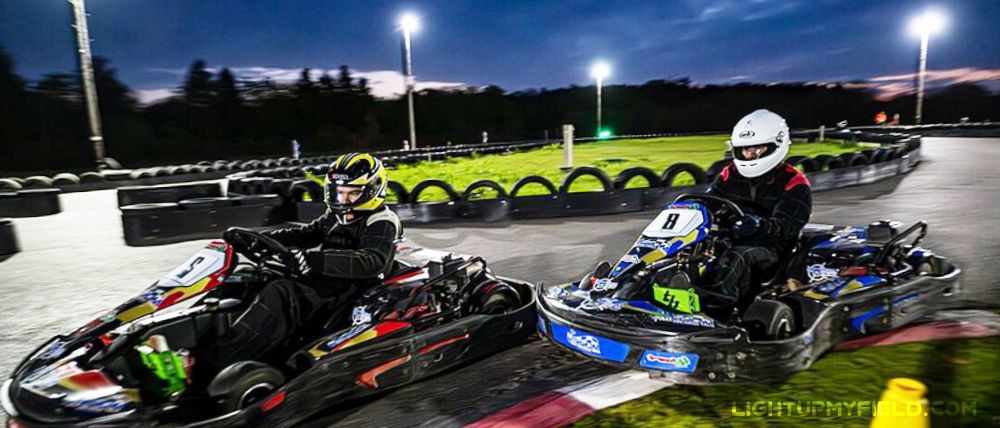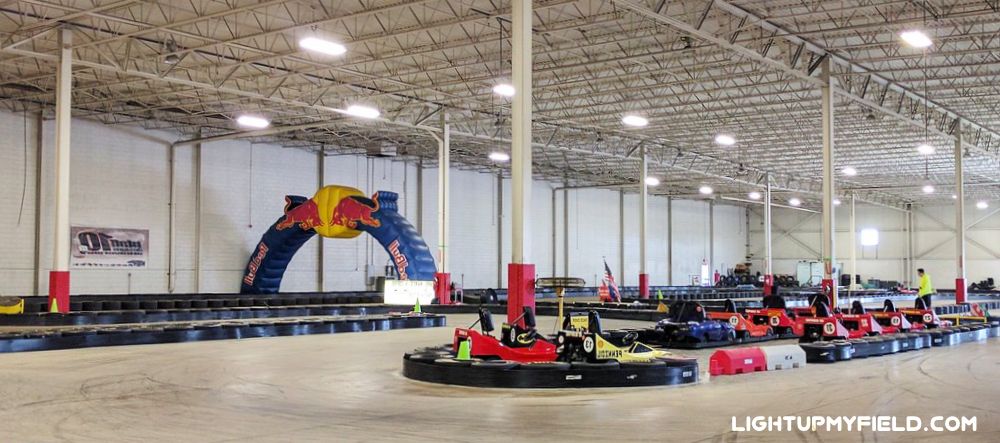Lighting may not be the first thing that comes to mind when people think about go-karting, but once the sun goes down, the right lighting setup can make all the difference between a fun, safe ride and a frustrating experience. Whether it’s a small indoor track tucked inside a warehouse or a large outdoor circuit hosting competitive races, the lighting level—measured in lux or foot-candles (fc)—plays a big role in how well drivers can see the course, judge corners, and react quickly.
So how much light does a go-kart track really need? Let’s look into what lux and foot-candles mean, how different tracks require different lighting levels, what happens if the lighting is too dim or too bright, and how to check if a setup meets the standards.
Table of Contents
ToggleWhat Are Lux and FC in Lighting?
Before diving into the actual numbers, it helps to know what these units stand for. Lux is a metric unit that measures the amount of light hitting a surface—specifically, one lumen per square meter. It tells us how bright a surface appears to the human eye. The higher the lux number, the brighter the space feels.
Foot-candles (fc), on the other hand, are commonly used in the United States. One foot-candle equals one lumen per square foot. To convert between them, you can remember that 1 foot-candle = 10.76 lux. So, if a lighting guide says a space should have 50 foot-candles, that’s about 538 lux.
For a go-kart track, both units can be used to describe how much illumination drivers get on the racing surface. While lux is more standard in international design specifications, many American venues still rely on foot-candles for lighting calculations.
Recommended Lux & FC Levels for Various Go-Kart Tracks

Lighting requirements for go-kart tracks aren’t one-size-fits-all. They change depending on the type of track, level of racing, indoor or outdoor setting, and even things like the track surface color, layout, and visibility for spectators or cameras. Designers and operators usually aim for a sweet spot where drivers can see clearly without glare, and the lighting remains efficient and consistent across the entire circuit.
| Track Type / Use | Recommended Illuminance (Lux) | Equivalent (Foot-Candles) | Typical Fixture Setup |
|---|---|---|---|
| Indoor – Casual / Family Karting | 300–500 lux | 28–46 fc | ~30–40 LED fixtures, wide beam (60°–120°) |
| Indoor – Competitive / Professional | 700–1000 lux | 65–93 fc | Dense LED layout, ceiling-mounted with focused optics |
| Outdoor – Recreational | 200–300 lux | 19–28 fc | Pole-mounted floodlights, 10–12 m high |
| Outdoor – Semi-Professional / National Level | 500–700 lux | 46–65 fc | Asymmetric beam LED floodlights on 10–14 m poles |
| Outdoor – International / Broadcast Standard | 800–1000 lux | 74–93 fc | Precision floodlights, often computer-aimed or adaptive |
| Small Indoor Track (350–400 m) | 300–700 lux | 28–65 fc | Around 30–40 fixtures |
| Large Outdoor Circuit (1 km or more) | 500–900 lux | 46–84 fc | 80–100 fixtures, variable beam angles |
| Casual / Rental Track (Evening Use) | 300–400 lux | 28–37 fc | Standard LED floodlights |
| League Racing / Driver Training | 600–800 lux | 56–74 fc | Adjustable-angle fixtures |
| Drifting / Endurance Karting | 700–900 lux | 65–84 fc | Reinforced lighting on pit lanes and paddock areas |
Indoor Tracks – Bright, Controlled, and Consistent
 Indoor go-kart tracks rely 100% on artificial light, so they naturally need higher illumination levels compared to outdoor circuits. Because the walls and ceilings often absorb light and there’s zero sunlight to help, achieving the right average maintained illuminance is key. For casual entertainment venues or family-style karting centers, keeping light levels around 300–500 lux (roughly 28–46 foot-candles) usually works great. At that range, drivers can easily see barriers, curves, and other karts without feeling blinded or fatigued.
Indoor go-kart tracks rely 100% on artificial light, so they naturally need higher illumination levels compared to outdoor circuits. Because the walls and ceilings often absorb light and there’s zero sunlight to help, achieving the right average maintained illuminance is key. For casual entertainment venues or family-style karting centers, keeping light levels around 300–500 lux (roughly 28–46 foot-candles) usually works great. At that range, drivers can easily see barriers, curves, and other karts without feeling blinded or fatigued.
For more competitive or professional-grade indoor karting—where drivers might reach speeds of 60–80 km/h (37–50 mph)—it’s better to aim higher, around 700–1000 lux (65–93 fc). That level of brightness allows racers to pick up subtle surface cues like tire wear, rubber buildup, and track markings. These small visual details help them brake more accurately and handle corners smoothly.
A big thing about indoor lighting is uniformity. If one corner of the hall is bright and another is shadowy, drivers’ eyes will constantly adjust, which is distracting and even a little dangerous at high speeds. Lighting designers often aim for a uniformity ratio (Emin/Eavg) of 0.7 or above, meaning the dimmest areas are at least 70% as bright as the average. That’s a solid benchmark for comfortable visibility.
Outdoor Tracks – Balanced with Natural and Artificial Light

Outdoor go-kart tracks bring another set of challenges. They’re larger, open to the elements, and sometimes used at night when natural light disappears completely. For recreational outdoor circuits, about 200–300 lux (19–28 fc) evenly spread over the track usually provides enough visibility for evening sessions or night racing. Corners, braking zones, and pit areas should get a bit more—around 350–450 lux (32–42 fc)—because those are areas where drivers make split-second decisions.
For semi-professional or national-level outdoor tracks that host races with higher speeds and tighter competition, the brightness usually goes up to 500–700 lux (46–65 fc). This helps drivers see long stretches of track clearly while keeping glare under control. The lights are typically mounted on 10–14 meter poles fitted with asymmetric beam LED floodlights that spread light evenly without blinding drivers or spectators.
When it comes to international-grade circuits—like those used for televised events or championship races—the standards can go even higher. You’ll often see setups delivering 800–1000 lux (74–93 fc) on the track surface. This ensures that not only do drivers have excellent visibility, but also that broadcast cameras can capture every turn and overtaking move in sharp, well-lit detail. Some premium facilities even integrate adaptive lighting control systems that adjust brightness dynamically based on race mode, time of day, or even weather.
Track Size, Layout, and Geometry
Track dimensions make a big difference in lighting design. A small indoor course of 350–400 meters can often be well-lit using about 30–40 fixtures, usually high-output LED panels with beam angles between 60° and 120° for broad coverage.
Meanwhile, a large 1-kilometer outdoor circuit might need upwards of 80–100 fixtures mounted at various angles and heights to ensure full coverage with no dark zones. Tracks with elevation changes, bridges, or multi-level structures need additional lighting layers to fill vertical gaps and minimize shadow contrast.
Complex layouts with sharp turns, hairpins, or chicanes benefit from targeted accent lighting—extra fixtures focusing on tricky corners to highlight curbs and apexes. The idea is to make the visual transition between straight sections and turns smooth, without any sudden jumps in brightness.
Level of Competition and Frequency of Use
How the track is used also shapes how much light you need. A casual rental track where groups race occasionally in the evening can function perfectly fine at around 300–400 lux (28–37 fc). But once you move into league racing, driver training, or time attack events, you’ll want at least 600 lux (56 fc) or more to keep everything sharp and precise.
For drifting or endurance karting, where drivers might be out for 30–60 minutes at a time, higher lux levels—closer to 800 lux (74 fc)—help reduce fatigue and eye strain. These setups also often include stronger lighting in pit lanes, paddock areas, and spectator stands, so people can move safely without shadows or dark spots.

Surface, Color, and Reflectance
The track surface color has a surprisingly big impact on perceived brightness. Dark asphalt (reflectance factor around 0.10–0.15) absorbs light quickly, so it usually needs 10–20% higher illumination to appear equally bright as a light concrete surface (reflectance 0.25–0.30). That means a dark-surfaced track that looks fine at 300 lux might need 350–360 lux instead to achieve the same visibility.
Painting the curbs or edge lines with high-reflectance paint (reflectance 0.70 or higher) can help make track boundaries pop even with moderate lighting. Some facilities use retroreflective tapes on barriers to enhance peripheral vision for drivers without adding more fixtures.
Weather, Glare, and Environmental Conditions
Outdoor lighting has to fight more than just darkness. Fog, humidity, or rain can scatter light and create a hazy effect that reduces contrast. To compensate, designers often choose narrower beam optics (like 30°–45°) or increase brightness slightly by about 10–15% on humid nights.
Minimizing glare is another major point. High-intensity lights positioned too low or at poor angles can create disability glare, which temporarily blinds drivers. Using asymmetric floodlights with cutoff angles above 60° helps keep the beams focused on the track and out of drivers’ eyes. The goal is high vertical illumination on curves and braking zones while avoiding direct light into the line of sight.
Color Temperature and Visual Comfort
The color temperature of the light also changes how the track feels and how visible the surface is. Warmer tones, around 3000K, give a cozy, relaxed feel but can make it harder to see small surface details or color differences. Cooler whites, around 4000–5000K, boost contrast ratio and help drivers pick out braking points and apexes more easily.
Some newer installations even use tunable white LEDs, allowing operators to shift color temperatures depending on the event—warmer for casual sessions and cooler for competitive racing. This flexibility also helps with color rendering index (CRI), which ideally should be above 80 for clear, natural visibility.
What Happens If Too Many or Too Few Lux/FC Are Adopted?
Finding the right lighting balance on a go-kart track can be surprisingly tricky. It’s not just about throwing more lights around or keeping the bills low—it’s about how the human eye reacts to brightness, contrast, and motion at speed. Both under-lighting and over-lighting bring real problems that affect visibility, driver comfort, and even energy efficiency.
When There’s Too Little Light
Too little light is one of the most common mistakes, especially for small or older tracks trying to save on electricity. When the average illuminance falls below 200 lux (around 19 fc) on the track surface, the difference becomes noticeable right away. Drivers start to miss visual cues—the edges of corners blur, braking zones look shorter than they really are, and reflections on glossy surfaces vanish.
At racing speeds of 40 to 60 mph (65–95 km/h), a driver only has a fraction of a second to react. A dim section of track can translate to a 0.3–0.5 second delay in reaction time, which could mean an extra 3–5 meters of travel before braking—plenty of distance for a collision in a tight corner.
Low light also causes eye strain and visual fatigue, especially indoors where there’s no natural light cycle to help the eyes adjust. The pupils constantly dilate to catch more light, making it harder to focus on moving objects. After 15 or 20 minutes of racing in poor lighting, drivers start blinking more often and lose precision in their control.
Another issue that sneaks up is uneven lighting, also called poor uniformity ratio. Even if the average lux seems fine on paper, dark patches or unevenly lit corners mess with depth perception. When the contrast between bright and dim zones exceeds a 3:1 ratio, drivers can misjudge turns or speed differences, leading to oversteering or sudden braking.
And it’s not just drivers affected by dim lighting. Walkways, pit lanes, and viewing areas can become unsafe for spectators and staff. A pit crew working under 100 lux lighting may struggle to read gauges or refuel safely. It’s a chain reaction that starts with visibility and ends with safety and confidence on the track.
When There’s Too Much Light
It might sound like the easy fix is to just make everything brighter—but that’s not always better. Over-lighting brings its own set of problems. Once levels climb past 1000–1200 lux (93–112 fc) on a go-kart track, the environment can start to feel harsh and uncomfortable. The biggest issue is glare—when light is so intense that it scatters inside the eye, reducing contrast and making objects harder to see clearly.
High glare levels are particularly troublesome when a driver exits a turn and looks toward a floodlight. Even a brief 0.2-second glare flash can blind the eyes momentarily, which at 50 mph means traveling over 4 meters completely blind. That’s why lighting designers focus heavily on cutoff angles, keeping fixtures pointed downward at less than 60 degrees from horizontal to avoid direct exposure to drivers’ lines of sight.
Over-lighting can also “wash out” visual detail. When surfaces are flooded with too much brightness, it becomes harder to read textures, tire marks, or colored kerbs. Reflective signage or safety barriers might appear blindingly white, reducing their usefulness. On-camera, excessive brightness can even cause overexposed footage, making televised or recorded races look flat and unrealistic.
For outdoor venues, too much light spills beyond the track boundaries and adds to light pollution. Nearby neighborhoods or wildlife areas might experience unwanted brightness, which not only annoys residents but can violate local lighting ordinances. In some regions, tracks have to meet IESNA or EN 12193 lighting guidelines that limit upward light output ratios to under 5% to reduce skyglow.
Then there’s the energy side. Floodlights running beyond what’s necessary waste electricity fast. For a medium-sized track using 80 LED fixtures at 500 watts each, bumping brightness from 700 to 1000 lux could add roughly 12–15 kWh per operating hour. That translates to $2,500–$3,000 more per year in electricity costs—without any meaningful improvement in visibility.
The Sweet Spot for Comfort and Performance
The best setups land in a comfortable “sweet spot”, usually between 400 and 800 lux (37–74 fc) for most go-kart environments. This range keeps the visual adaptation curve smooth—drivers can transition naturally between sections without squinting or over-adjusting. It also keeps the Unified Glare Rating (UGR) below 22, which is ideal for visual comfort in high-speed sports lighting.
Uniformity and color rendering matter just as much as raw brightness. A well-designed system with a uniformity ratio of 0.7 and a CRI (Color Rendering Index) above 80 will always outperform a poorly distributed, overly bright setup. That’s because good visibility comes from clarity and consistency, not just intensity.
Getting lighting right isn’t about chasing big numbers—it’s about matching the brightness to the track’s needs, the driver’s perception, and the environment. Too dim, and drivers lose confidence. Too bright, and their vision gets overloaded. Finding that middle ground keeps everyone safe, comfortable, and focused on what matters most—racing.
How to Measure the Lux and FC Levels in a Go-Kart Track
Once all the lights are installed and glowing, it’s tempting to stand back and think, “Looks bright enough.” But our eyes can be deceiving—especially at night or under mixed lighting conditions. What feels evenly lit might actually have dark patches, glare spots, or huge differences in brightness across the surface. That’s why it’s so useful to measure and verify light levels properly. It helps confirm that the track meets its target standards and delivers consistent visibility for every driver and spectator.
Using a Lux or Foot-Candle Meter
The most straightforward way to measure light intensity is with a lux meter (or a foot-candle meter in regions using imperial units). These handheld devices measure the illuminance—that’s the amount of light falling on a surface. They’re compact, inexpensive, and reliable when used correctly.
To get realistic readings, measurements should be taken at about 1 meter (3.3 feet) above ground, which roughly matches the eye level of a seated driver. The sensor should face straight up, not tilted, to ensure the reading represents the light actually reaching the track surface and a driver’s line of sight.
Lighting engineers typically create a measurement grid, marking points about 5 to 10 meters apart across the entire track. This grid ensures data isn’t just taken in one spot but represents the whole layout—including straights, corners, pit lanes, and spectator areas. A small indoor track might have 30 to 40 measurement points, while a 1-kilometer outdoor circuit could have well over 100 readings.
After collecting the data, the average illuminance (Eavg) gives a good sense of overall brightness. The minimum (Emin) and maximum (Emax) readings then help calculate the uniformity ratio—which is usually Emin/Eavg. Ideally, this value should be around 0.7 or higher, meaning the dimmest area still has at least 70% of the brightness of the average lighting. Anything lower than 0.5 might indicate patchy coverage or poor fixture alignment.
Modern lux meters can also log data automatically and export it to software, which makes analysis much easier. Some advanced models even measure color temperature (Kelvin) and CRI (Color Rendering Index) at the same time—handy for checking that lights match the desired tone (like 4000K cool white) and color quality (CRI above 80).
Using Lighting Simulation or Photometric Software
Before the lights even go up, professional lighting designers often rely on simulation and photometric analysis tools. Software like Dialux, Relux, or AGi32 can model the entire go-kart track in 3D and predict how light will behave in different scenarios.
These programs use the IES or LDT photometric files provided by fixture manufacturers. Each file contains data about how a specific light distributes its output—its beam angle, luminous intensity, and shape. By inputting this data, designers can simulate multiple setups: changing pole heights from 10 meters to 14 meters, rotating beam angles, or comparing 400W vs. 600W LED floodlights.
This kind of virtual testing helps fine-tune the design before spending money on equipment. For example, a simulation might show that increasing pole height from 10 to 12 meters improves uniformity by 15%, or that slightly rotating fixtures by 5 degrees eliminates shadowing in tight turns.
Still, simulations can’t capture every real-world factor. Once the system is installed, on-site verification is a must. Track surfaces, wall colors, or even nearby reflective objects can alter how light behaves. That’s why after installation, the same grid-based lux meter testing is repeated to confirm that the theoretical numbers match reality.
Regular Maintenance and Re-Testing
Even the best lighting systems fade over time. Dust and grime build up on fixture lenses, LEDs lose some efficiency, and metal halide lamps can drop 20–30% in brightness after just a few thousand hours. Regular maintenance keeps lighting consistent and safe.
It’s good practice to re-measure the light levels every 6 to 12 months, depending on how often the track is used. High-traffic indoor venues, where lights run daily, might need quarterly checks, while outdoor circuits could stretch to annual assessments.
Maintenance usually includes cleaning fixture lenses, checking pole angles, tightening brackets, and replacing any lamps or drivers that show significant dimming. Some facilities also recalibrate their systems after seasonal changes—since humidity, fog, or temperature shifts can slightly affect light output and reflection.
LED systems have made things much easier in recent years. A good-quality LED floodlight can maintain 90% of its original lumen output even after 50,000 hours of use—that’s roughly six years of nightly operation. Still, dust or misalignment can mess up the uniformity ratio, so physical inspection remains part of the routine.
Smart Monitoring and New Tech Options
More advanced tracks today are starting to use smart lighting control systems that automatically monitor and adjust brightness. These systems can dim or boost output based on event type or ambient light levels, keeping lux and fc values within the ideal range without wasting energy. Some even come with real-time sensors that track illuminance changes and flag when readings drop below a threshold.
For example, if an outdoor track usually operates at 600 lux but sensors detect it’s fallen to 500 lux in one section, the system can increase output from that zone’s fixtures automatically. Over time, this helps maintain uniform brightness, saves energy, and extends fixture life.
Keeping Consistency on Track
Measuring and maintaining proper lux and foot-candle levels isn’t just about numbers—it’s about creating a safe, comfortable, and fair racing environment. A track that’s been accurately tested and regularly checked feels smoother to drive on, photographs better, and runs with fewer lighting issues during events.
Finding the Right Balance for Great Racing
Lighting might seem like a behind-the-scenes detail, but it shapes how safe and exciting a go-kart experience can be. The right lux or foot-candle levels depend on the setting—indoor vs. outdoor, casual vs. competitive, small vs. large—but the goal stays the same: give drivers enough visibility to race confidently and react quickly.
Too little light creates hazards; too much causes glare and wasted energy. Striking that middle ground, backed by accurate measurements and thoughtful design, lets the track shine—literally and figuratively.
When done right, a well-lit go-kart track doesn’t just illuminate the surface; it elevates the entire racing experience.

